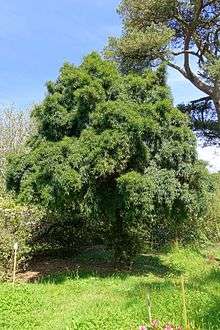Podocarpus salignus
Podocarpus salignus, the willow-leaf podocarp,[2] is a species of coniferous evergreen tree in the family Podocarpaceae. It is found only in Chile, from 35 to 42° south latitude, where it is threatened by habitat loss. Growing up to 20 m (66 ft) in height and 1 m (3 ft) in diameter, the trunk is straight and cylindrical, with reddish-gray bark. The arching branches bear long, narrow, willow-like leaves, and red fleshy oval fruits where male and female plants are grown together. In Chile it is known as Mañío de hojas largas (long-leaved).
| Podocarpus salignus | |
|---|---|
 | |
| Scientific classification | |
| Kingdom: | Plantae |
| Clade: | Tracheophytes |
| Division: | Pinophyta |
| Class: | Pinopsida |
| Order: | Pinales |
| Family: | Podocarpaceae |
| Genus: | Podocarpus |
| Species: | P. salignus |
| Binomial name | |
| Podocarpus salignus D.Don | |
Cultivation and uses
This tree is grown in gardens and parks of Chile, and has been introduced to the British Isles. It requires heavy rainfalls or high humidity, but withstands temperatures down to −25 °C (−13 °F).[3] It has gained the Royal Horticultural Society's Award of Garden Merit.[2][4]
The wood is of good quality, yellowish colored, straight grained, and highly moisture resistant. It is used in furniture and construction.
References and external links
- Gardner, M. (2013). "Podocarpus salignus". IUCN Red List of Threatened Species. 2013: e.T32030A2808753. doi:10.2305/IUCN.UK.2013-1.RLTS.T32030A2808753.en.
- "RHS Plant Selector - Podocarpus salignus". Retrieved 28 May 2013.
- Huxley. A. The New RHS Dictionary of Gardening. 1992. MacMillan Press 1992 ISBN 0-333-47494-5
- "AGM Plants - Ornamental" (PDF). Royal Horticultural Society. July 2017. p. 80. Retrieved 7 May 2018.
- Donoso, C. 2005. Árboles nativos de Chile. Guía de reconocimiento. Edición 4. Marisa Cuneo Ediciones, Valdivia, Chile. 136p.
- Hechenleitner, P., M. Gardner, P. Thomas, C. Echeverría, B. Escobar, P. Brownless y C. Martínez. 2005. Plantas Amenazadas del Centro-Sur de Chile. Distribución, Conservación y Propagación. Universidad Austral de Chile y Real Jardín Botánico de Edimburgo, Valdivia. 188p.
- Hoffman, Adriana 1982. Flora silvestre de Chile, Zona Araucana. Edición 4. Fundación Claudio Gay, Santiago. 258p.
- Rodríguez, R. y M. Quezada. 1995. Gymnospermae. En C. Marticorena y R. Rodríguez [eds.], Flora de Chile Vol. 1, p 310–337. Universidad de Concepción, Concepción.
- Bean. W. Trees and Shrubs Hardy in Great Britain. Vol 1 - 4 and Supplement. Murray 1981.
- Usher. G. A Dictionary of Plants Used by Man. Constable 1974 ISBN 0-09-457920-2.
- F. Chittendon. RHS Dictionary of Plants plus Supplement. 1956 Oxford University Press 1951.
- Huxley. A. The New RHS Dictionary of Gardening. 1992. MacMillan Press 1992 ISBN 0-333-47494-5
- Conifer Specialist Group 1998. Podocarpus salignus. 2006 IUCN Red List of Threatened Species. Downloaded on 10 July 2007.
- " Podocarpus salignus ". Encyclopedia of Chilean Flora. Retrieved 2009-06-27.
- "Growing Podocarpus salignus in the British Isles". Plants for a Future. Retrieved 2009-06-27.
- Conifers Around the World: Podocarpus salignus - Willow-Leaf Podocarp
